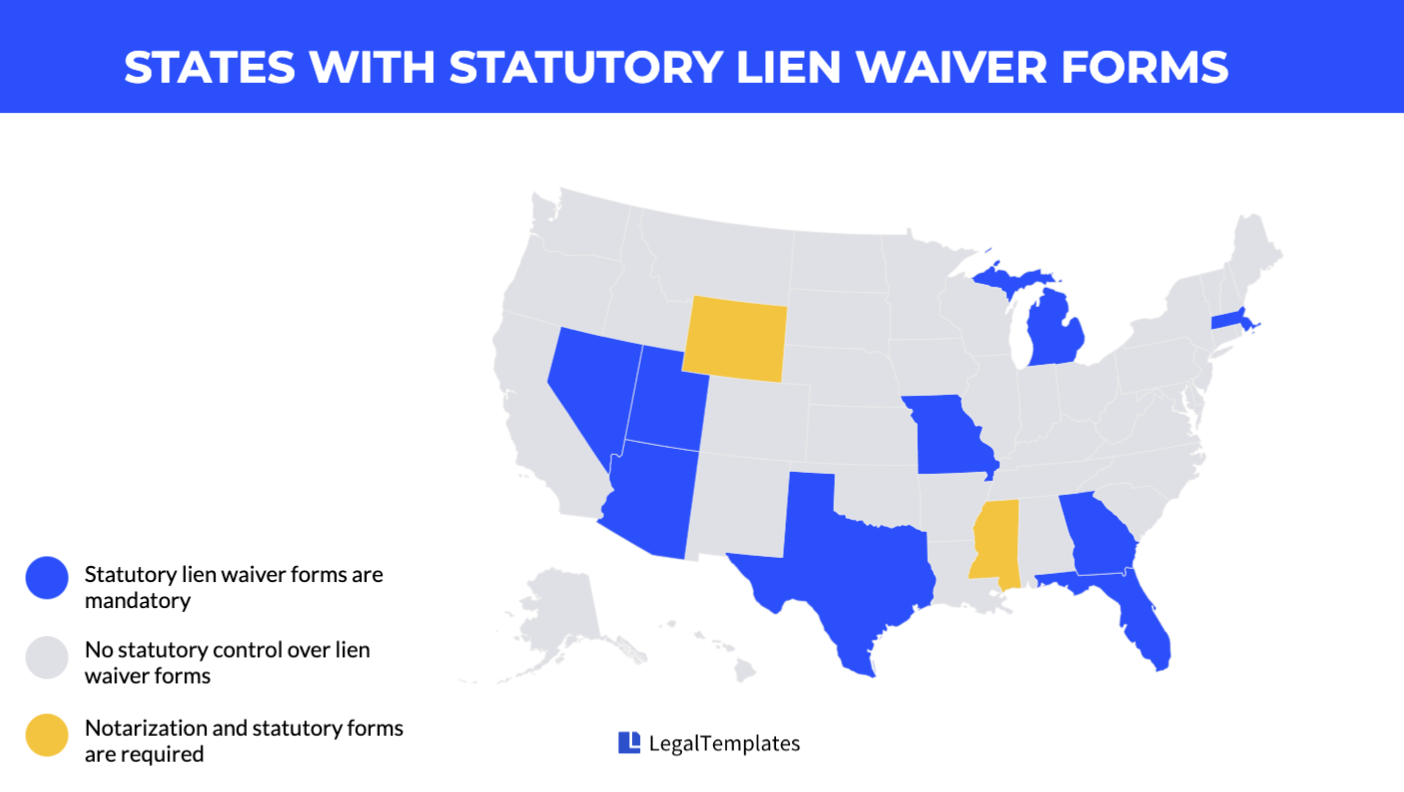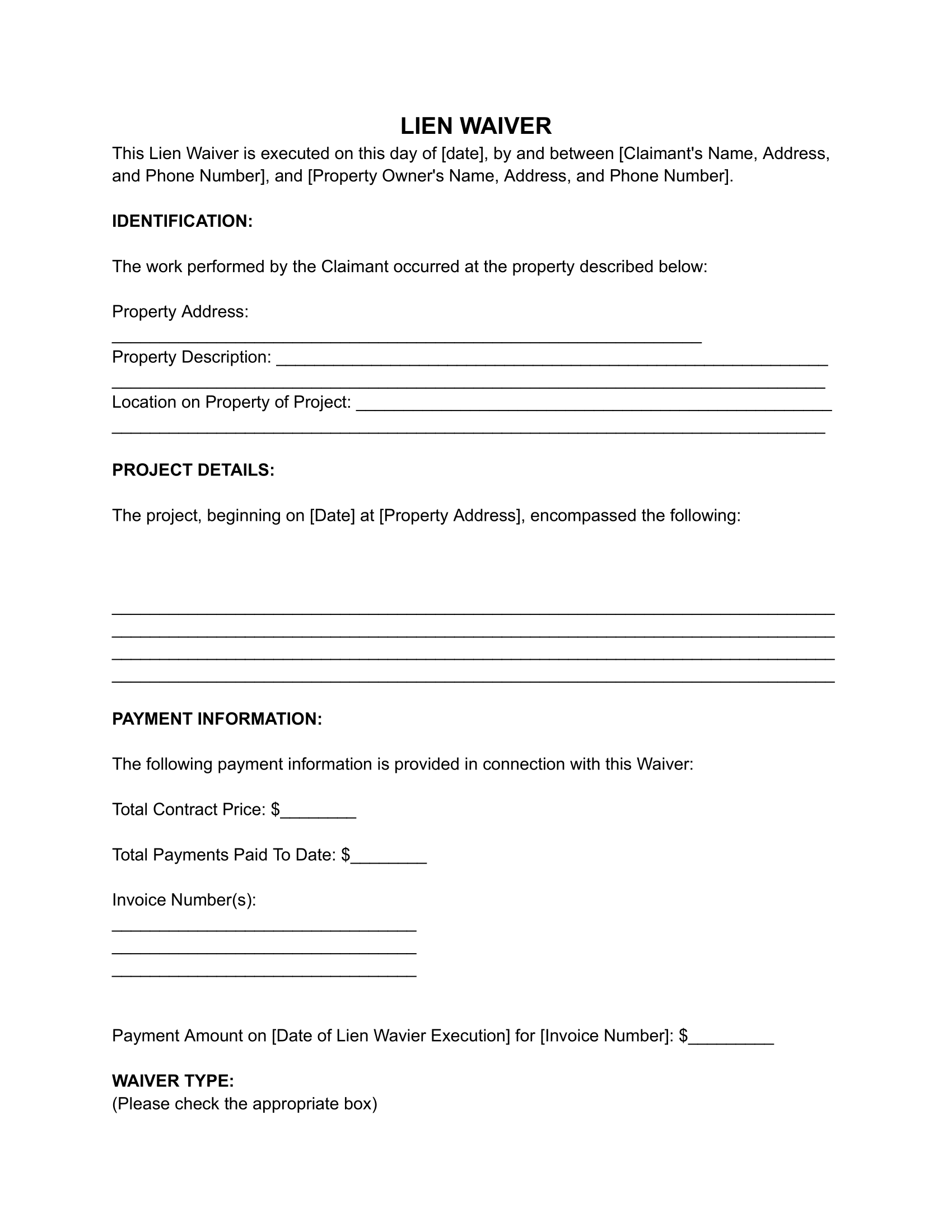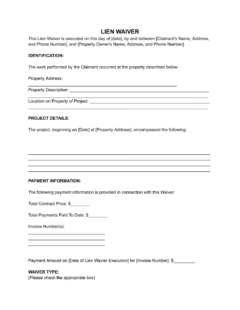
Use it to confirm settlement of payments for subcontractors, suppliers, and day laborers in construction.
Updated September 26, 2023
Reviewed by Brooke Davis
A lien waiver is a legal document between a service or product provider and the recipient that waives the provider’s right to file a lien on the property.
Construction companies often use it to manage payment for services and supplies. Other organizations that use lien waiver forms include construction businesses, equipment rental companies, and construction lenders.
Typically, the involved parties exchange a lien waiver upon service completion and payment receipt.
They are commonly used to:
Lien waivers may be conditional or unconditional. Progress waivers discharge lien rights for payments up to a certain date. Final payment waivers require payment in full to discharge lien rights.
The claimant provides a conditional lien waiver before receiving payment, giving up their right to file a lien once they get paid as agreed.
Conditional liens may require full payment for the entire project or partial payments applied to certain dates. Once the claimant has received the agreed payment on a conditional waiver, they waive their right to file a lien on the property.
This type of lien waiver is issued after receiving payment and doesn’t require any additional conditions for that specific payment.
In the construction industry, a general contractor will often collect lien waivers from the subcontractors and suppliers before beginning the project. Advance conditional releases make lien waivers and payment processes easier to navigate with multiple parties.
The primary difference between a lien waiver and a release is whether a lien has already been filed.
A lien waiver typically applies before a lien is placed on a property. Generally, if the client adheres to the agreed payment process, the claimant will not file a lien.
A lien release, or lien cancellation, occurs after a lien has already been filed. If a claimant has filed a lien on the property for nonpayment, the client will usually have to pay them for their products or services to have the lien released. The client may have the option to pay a debt using:
The lien is typically not released until the claimant receives full payment. If a property owner is trying to sell the disputed property, using a pay app can ensure the debt is paid faster. The time and effort involved in releasing a lien makes lien waivers especially useful for contractors and their clients.

States regulate lien waivers differently. The following 12 states provide lien waiver forms and guidelines to ensure fair use:
Wyoming (§ 29-10-101) and Mississippi (§ 85-7-433) require lien waivers to be notarized.
Waivers provided by the states will cover certain legal requirements, but you should include details for your specific project. Be sure to thoroughly review the agreement terms before signing.
Managing lien waivers can be complicated. Download this fillable Word or PDF lien waiver form to streamline the lien waiver process:

Before you sign a waiver, ensure that the document clearly outlines the terms of the waiver, including amounts owed for services and products provided. Careful review can ensure your right to future payments, even after a client’s bankruptcy or liquidation.
To write an effective lien waiver for your project, include the following :
The claimant may be a contractor, subcontractor, or supplier. Include the name, phone number, and address of the company or individual providing services or products under this contract.
The property owner may be an individual homeowner, landlord, or commercial property owner. Include the property owner’s name, address, and phone number and their representative.
Indicate the property’s address or parcel number. Describe the property in detail and include the location of the project on the property. For example, if the lien waiver is for a house bathroom remodel, indicate the floor, the side of the house, and adjacent rooms.
State the project’s starting date and property address, and outline the full scope of work. Include the work to be performed, hours, supplies, number of workers, subcontracted work, equipment, and other project information.
Ensure you include the full price of the contract and the number of payments expected. If the contract is for a progressive waiver, indicate the amount and dates of any payments received to date and note their associated invoice numbers. Include a list of all submitted invoices, whether or not they have been paid.
Specify whether the waiver is a conditional or unconditional lien waiver. State whether the waiver is a partial waiver for payment up to the date indicated or a final lien waiver for payment in full.
By signing the document, the claimant personally attests that the information in the waiver is true and accurate. For an unconditional waiver, the claimant’s signature makes the waiver effective immediately. For conditional waivers, the contractor’s right to file a lien is waived upon receipt of payment as agreed.
If your state requires notarization (Mississippi and Wyoming), do not sign the waiver until you are before a notary. The claimant must sign and date the lien waiver document before a notary for it to be valid.
Unconditional waivers are signed upon receipt of payment for products and services rendered. Conditional waivers are signed before payment is received, but the waiver is conditional upon receiving payment.
A progress payment is a partial payment that assigns a certain amount to be paid by a specific date. Progress payments may be part of a set payment plan or apply to costs incurred within the indicated time frame.
A final payment may be a lump sum payment for the full project or the final payment on a progressive payment plan. A conditional or unconditional final lien waiver discharges the claimant’s rights to file a lien on the property once the final payment is received.
Lien waivers benefit the paying party by preventing the claimant from seeking additional payments beyond the agreed amount. The lien waiver is essentially a receipt for payment that prevents the claimant from filing a lien on the property.

Create Your Lien Waiver in Minutes!